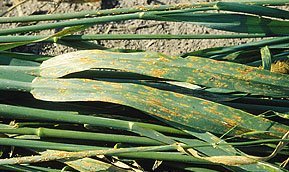Leaf Rust In Wheat, Barley, And Oats
Rust has the potential to be a serious threat to all small grains. Leaf rust can cause up to 25% yield loss under favourable conditions. Leaf rust in oats is commonly referred to as crown rust.


Host Crops
Wheat, barley and oats
Biology
Leaf rust overwinters in the southern USA and is blown into the southern Prairies by prevailing winds. It is recognized by its characteristic orange-red pustules that erupt from the upper surface of leaves. Rust spots are very small, circular or elongated, and are vivid orange red in colour. They may occur on stems but are most common on the upper surface of the leaves.
These pustules are approximately the size of a pin head and filled with thousands of orange-red spores that are wind-borne and can infect additional leaves and wheat plants. The spores often form the core of rain drops and initially infect and produce pustules where the raindrops have collected at leaf axils and tips.
When heavily infected, the whole leaf will die. Winds can carry rust spores for great distances. The disease can develop rapidly at temperatures between 11-22 degrees C (52-72 degrees F) when moisture is not a limiting factor.
Symptoms Of Damage
Leaf rust pustules are dusty-yellow to bright-orange, small round to oval spots that are found on the leaves and sheaths. As the plant matures, the rust pustules darken and may appear black.
Scouting Techniques
Look for small, round, orange pustules on the leaves and leaf sheaths. As the plant matures, the pustules darken.
Economic Thresholds
In some states in the USA, fungicide application is recommended if there is an average of one leaf rust pustule per leaf. Spraying is recommended if the threshold is met in three of the five spots sampled in the field. Repeat scouting in about four days if the threshold is reached at one or two of the spots in the field. Spray decisions should involve scouting information as well as rainfall forecasts. Severe disease development will be favoured by heavy rainfall. If the weather is very dry, intervals between scouting can be extended.
Control Tips
Consult your provincial seed guide and seed resistant varieties if rust is a recurring disease. Early seeding may help reduce high infection levels. Use foliar applied fungicides.

